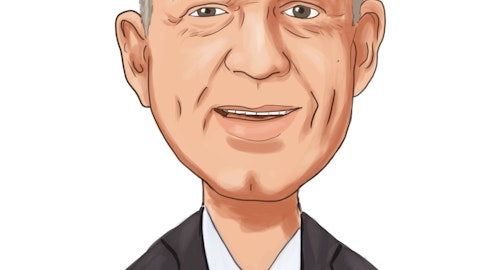KT Corporation (NYSE:KT) Q2 2023 Earnings Call Transcript August 7, 2023
Operator: [Foreign Language] Good morning and good evening. Thank you all for joining this conference call. And now we will begin the conference of our 2023 Second Quarter Earnings Results by KT. We would like to have welcoming remarks from Mr. Seung-Hoon Chi, KT IRO; and Young-Jin Kim, the CFO, will present earnings results and entertain your questions. This conference will start with the presentation followed by a Q&A session. [Operator Instructions] Now, I would like to turn the conference over to Mr. Seung-Hoon Chi, KT, IRO.
Seung-Hoon Chi: [Foreign Language] [Interpreted] Good afternoon. I am Chi Seung-Hoon, KT’s IRO. Let’s begin KT’s second quarter 2023 earnings presentation. For your information, this earnings release call is being webcast live on our website, and you can follow the slides as you listen in on the call. Before we begin, please note that today’s presentation includes financial statements and operating results under the K-IFRS standards that have not yet been reviewed by an outside auditor. As we cannot ensure accuracy and completeness of financial and business data, aside from the historical performance, please be reminded that these figures may be subject to change. With that, I will now invite our CFO, Kim Young Jin for his remarks and presentation on the second quarter earnings results.
Young-Jin Kim: [Foreign Language] [Interpreted] Good afternoon. I am Kim Young Jin, KT’s CFO. I will begin with key earnings highlights for the second quarter of 2023. Supported by KT’s solid fundamentals in B2C and B2B and robust growth from group’s core portfolio, including finance, real estate, media content and DX businesses, second quarter consolidated and stand-alone operating profit both recorded a double-digit growth. Despite rise in business expenses on higher inflation, earnings outperformed market expectations on the back of cost efficiency gained from improvement in business implementation, such as strengthening of distribution and improving outsourcing structure, which bolstered profitability. Second quarter stand-alone service revenue, hence, was KRW4,018.6 billion and operating profit recorded KRW407.5 billion.

Photo by Mario Caruso on Unsplash
Each posted a growth of 2.1% and 34.2% year-over-year, respectively. And since 2010 for the first time in 13 years, quarterly service revenue reached KRW4 trillion level. Consolidated revenue recorded KRW6,547.5 billion, while operating profit was KRW576.1 billion, up 3.7% and 25.5% year-over-year, respectively. And KT’s BoD made the decision to appoint Kim Young-shub as the new CEO of the company on August 4. The incoming CEO will be officially appointed after the approval of shareholders during the second Extraordinary General Meeting of Shareholders to be held on August 30. By removing governance-related uncertainties and based on solid fundamentals, KT will continue to strive towards corporate value enhancement in the second half of the year.
I will now move on to earnings for second quarter of ’23. Operating revenue was KRW6,547.5 billion, up 3.7% on-year. Operating profit came in at KRW576.1 billion, up 25.5% year-over-year on the back of stronger profitability, which is an outcome of better cost efficiencies following improvement on structure for business implementation. Net profit was up 19% year-on-year, recording KRW432.5 billion, while EBITDA increased 8.5% on-year, reaching KRW1,505.3 billion. To the next page, let’s take a look at operating expense. On the back of business expansion-related spending and rise in inflation, operating expense was up 2.0% year-over-year to KRW5,971.4 billion. Then, financial statement. Debt-to-equity ratio as of June-end ’23 reported 115.4%, down 6.1 percentage points Q-on-Q.
Net debt-to-equity ratio was also down 2 percentage points Q-over-Q to 44.6%. CapEx. Cumulative CapEx for KT Group as of Q2 was KRW1,383.8 billion. While on a KT stand-alone basis, Q2 cumulative CapEx recorded KRW998.5 billion. Group subsidiary CapEx, which includes core growth businesses of finance, media and content, cloud and IDC, real estate, recorded KRW385.3 billion, in line with our annual CapEx plan. Business breakdown. Telco B2C business posted a growth of 0.8% on-year, reporting KRW2,390.2 billion on the back of expanded customer base, centering on premium services. Supported by growth in 5G subscribers and higher domestic roaming demand seen from inbound visitors, wireless revenue was up 0.8% on-year to KRW1,562 billion. We now have 9.280 million 5G subscribers, accounting for 68% of total base of subscribers.
Broadband Internet revenues saw a 2.7% on-year growth, reaching KRW612.4 billion, driven mostly by GiGA Internet subscriber growth. Fixed-line revenue was down 4.2% year-on-year to KRW215.8 billion. Next is on DIGICO B2C business. An evenly spread out growth coming from media and mobile platform, DIGICO B2C business was up 3.8% year-over-year, reporting KRW575.6 billion. IPTV business reported 1.2% year-over-year growth, underpinned by growth in high ARPU subscriber base. Next is on Telco B2B. Telco B2B business was up 7.6% year-on-year, reporting KRW546.9 billion on the back of growth of both B2B Internet and data and enterprise voice call businesses. B2B Internet and data business was up 5.2% on-year on the back of higher demand for lease lines for CCTVs and increase in orders booked from small to mid CPs. Enterprise Telephony business posted 12.3% year-over-year growth on sustained growth of MVNO’s typical product, which is the deferred payment scheme.
Next is on DIGICO B2B business. DIGICO B2B was up 0.6% on-year, reaching KRW505.9 billion. There was some impact from business rationalization, but it’s mostly been driven by revenue stream from projects that we’ve already booked, such as the projects of National Defense broadband integrated network, as well as an uptrend from five hotels, including Myeongdong’s Le Méridien and Moxy hotel, which was newly opened in November the — year 2022. Next is on subsidiary highlights. On higher credit card acquiring volume and sustained new business growth, including issuance of BC branded cards and lending business, BC Card revenue was up 5.9% on-year to KRW1,049.2 billion. Skylife revenue was up 2.8% on-year to KRW261.3 billion on growth from MVNO and Internet resale businesses.
KT Studio Genie and SkyTV released seven original dramas and five original entertainment programs during the first half of the year and is leading at the forefront of media and content market. Original content helped enhance our competitiveness in the channel and distribution through global OTTs and channels support popularity streak of these titles. But due to economic slump in the ad market, commerce market showed contraction and so the revenue from the content subsidiary was down 5.8% on-year, coming in at KRW268.9 billion. kt cloud in just one year since its launch, has proven its value as Korea’s top DX company. And based on KRW4 trillion valuation that it received, we successfully closed raising KRW600 billion of investment. Thanks to solid growth of our IDC business and as AI cloud business took off in full scale, revenue was up 18.5% year-over-year, recording KRW153.8 billion.
This has been a brief update on KT’s financial performance of Q2 of ’23. Despite macro headwinds of inflationary pressures and recession, KT’s B2C and B2B businesses have all shown robust growth, supported by its fundamentals, and we yet again witnessed growth potential of group’s portfolio of businesses. In the second half, under the leadership of newly appointed CEO, who is equipped with business caliber and ICT expertise, we will continue our endeavor to enhance KT’s corporate value. Once again, I extend my deep gratitude to our investors and analysts, and we ask for your continued interest and support. Thank you.
Seung-Hoon Chi: [Foreign Language] [Interpreted] Now for more information, please refer to the previously circulated presentation material. We will now move into Q&A session. Due to the time constraint, I would like to ask that you limit your questions to two per person.
See also Jim Chanos’ 5 Short Positions in 2023 and 11 Cheap Gold Stocks To Buy According to Analysts.
Q&A Session
Follow K T Corp (NYSE:KT)
Follow K T Corp (NYSE:KT)
Receive real-time insider trading and news alerts
Operator: [Foreign Language] [Operator Instructions] The first question will be presented by Hoi Jae Kim from Daishin Securities. Please go ahead with your question.
Hoi Jae Kim: [Foreign Language] [Interpreted] Thank you. I am Kim Hoi-Jae from Daishin Securities. I have two questions. I want to ask regarding your earnings results. First has to do with your top-line revenue, and second question relates to your cost. First, if we look at your second quarter earnings performance, it really outperformed market expectations. Is there any key drivers, maybe two or three key elements that you wish to highlight with regards to the background to this earnings result? And also, if you could provide some color as to what the second half outlook is from the perspective of the company, that would be helpful. Second question is on cost. High level of inflationary pressure seems to work as a burden on many companies, but it seems KT was able to really control its cost quite well.
I would like to understand as to what were the efforts that you put in to control such — to do cost control? And so that would be helpful if you could shed light on that aspect.
Young-Jin Kim: [Foreign Language] [Interpreted] Thank you, Mr. Kim, for asking two questions. You asked about the key performance regarding the revenue — top-line revenue, what were the key drivers and what our outlook is for the second half of the year as well as cost. So, why don’t I combine all of that and provide you with an answer. On the revenue side, I think we could highlight three key elements. So, the first element has to do with B2C business. We were able to drive quite steady performance because we focused on improving the quality aspect, especially quality sales activities with regards to our mobile Internet and TV business. The second element has to do with our B2B business. The projects that we have already won in the past, we are starting to see monetization.
We see revenue stream coming through. And in the first half of the year, we also saw growth in the number of orders that we were able to book. So, the new order expansion also was a key driver behind our B2B business growth. Third key driver behind the performance was from our subsidiaries. Our core portfolio of businesses, which includes finance, real estate, media and content, cloud and IDC, these areas were — have been able to bring about growth. So, in the same light, we were endeavor to continue to bring on growth from our B2C and B2B businesses, as well as from the businesses that’s part of our core group portfolio of businesses. So based upon these endeavors, we want to be able to bring about additional growth from the KT Group perspective.
Now, as you’ve pointed out, I believe inflationary pressure does work as a cost burden for most of the companies. KT is not an exception to that. The increases in the inflation did impact our electricity costs as well as different commissions paid items. However, within KT, we’ve been continuously placing momentum behind making our processes more efficient by making use of AI and other digital transformation technology and also bringing about improvement in the way we do business, the business implementation process status. So thanks to all of these efforts, to a certain extent, these activities helped us offset some of the cost increases, the pressures that we were exposed to. To provide you with a bit of more detail what we did was by expanding customer self-activation, we were able to optimize the entire activation-related dispatch workflow, and we applied AI across all of the call center related workflows.





